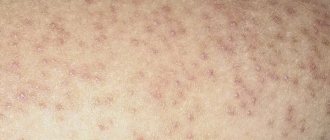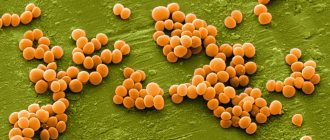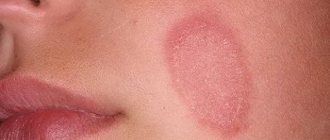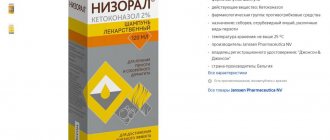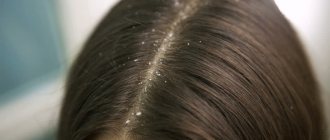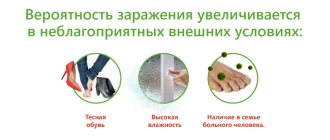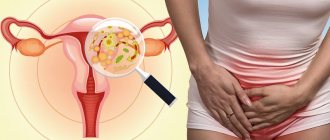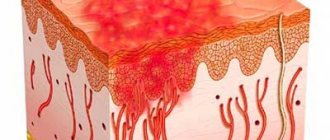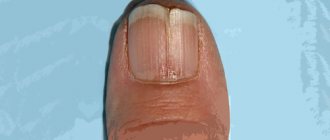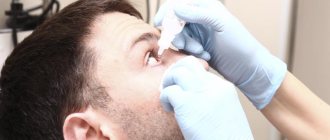Trichology (from the Greek “trichos” - hair, “logos” - science) is the science of hair and scalp, which studies the structure and physiology of hair, develops theoretical and practical methods for treating hair and scalp.
In the West, trichology as a separate scientific direction was formed in the middle of the 20th century. Since then, there has been a qualitative breakthrough in its development: from small scattered schools and individual doctors to large associations, centers and institutes for the study of hair. Trichology appeared in Russia later, in the early 1990s. And like any science, with the accumulation of scientific data, it has now acquired an integrated approach to the treatment of trichological diseases.
Reasons for visiting a trichologist
- increased hair loss,
- loss of hair volume,
- dandruff and itching of the scalp.
Scalp diseases: names and causes
Common skin diseases are considered to be:
- diseases of a dermatological nature (including seborrhea, eczema and hyperkeratosis);
- autoimmune diseases of the scalp (including psoriasis and scleroderma);
- infectious (formation of pustules, appearance of lice, etc.);
- fungal rashes.
Whatever the cause of the disease, it must be eliminated in time. It is important to start treatment as early as possible, because wasted time can have serious consequences.
Desquamative dermatoses of the skin
- Hyperseborrhea
is caused by increased activity of the sebaceous glands. It occurs due to poor nutrition, puberty, overwork, smoking, stress, environmental parameters, and can be a hereditary disease. - Seborrheic dermatitis
of the scalp appears as a result of disruption of the sebaceous glands. In the initial stage, it reveals itself as dandruff, followed by redness, itching, and bleeding wounds.
Treatment results for seborrheic dermatitis
Causes and signs of dermatological diseases
The appearance of dermatological diseases of the scalp in a patient occurs when the sebaceous glands work abnormally. For example, the well-known disease seborrhea occurs in people who constantly live in a stressful state, which leads to a malfunction of the gastrointestinal tract, and constant snacking on fast food and sweets only worsens the clinical picture.
Seborrhea can occur as a result of hormonal imbalance. Moreover, it is observed equally in both the male and female populations in equal numbers. Rare causes of the disease include hereditary predisposition. It's rare, but it happens. At the moment, doctors cannot answer with certainty which link in the genetic code is responsible for the transmission of seborrhea in the family.
Self-medication is not recommended - it can only cause harm. To establish an accurate diagnosis, you need to contact a specialist in skin diseases, who will refer you to an andrologist/gynecologist to identify pathological processes in the reproductive system. Based on the results obtained, adjustments are made to the diet, physiotherapy is prescribed, and, if necessary, a diet and a course of medications.
Infectious diseases
The most common infectious diseases of the hair and scalp are pediculosis, microsporia and trichophytosis. Pediculosis develops as a result of parasitism on the scalp by blood-sucking insects ─ head lice. Their bites are accompanied by severe itching, which leads to multiple scratches on the skin. In places of scratching, ulcers or scars often form. Hair loss due to pediculosis is minimal, but the structure of the hair itself is disrupted as parasites attach eggs (nits) to the hair shafts. To treat head lice, drugs based on benzyl benzoate are used. A prerequisite is the mechanical destruction of nits and adult lice.
Fungal infections of the hair and scalp include microsporia and trichophytosis (ringworm). On smooth skin, the lesions have rounded outlines; their shape is more clearly expressed in microsporia. The skin on the affected areas is hyperemic and covered with scales. Most patients experience extensive hair loss due to hair breaking off at a level of 2-6 mm from the surface of the skin. In places of hair loss, stumps (short fragments of hair) remain; with ringworm, their color is usually black, and with microsporia, it is whitish, resembling a mold coating. To treat these diseases, antifungal drugs are used in the form of local applications, injections or tablets for oral administration.
Fungal diseases: causes and symptomatic picture
Fungal diseases of the scalp partially or completely affect the scalp. They are transmitted through tactile contact and the use of shared personal hygiene products (towel, comb), clothing and hats.
A common fungal disease is ringworm. The superficial form most often affects children of preschool and school age due to curiosity and frequent contacts with animals - cattle and rodents. According to statistics, lichen more often affects residents of villages and villages.
In most cases, it is characterized by the appearance of small spots, pinkish with a pale edge. Despite its frequent distribution among children, trichophytosis can appear in men and women of different age categories.
Treatment of fungal diseases of the scalp can take an indefinite period of time. If the disease is chronic, treatment of the scalp disease in this case does not guarantee complete relief.
Hair diseases
Trichology
(“the study of hair” from the Greek trichos - hair, logos - science) - is a highly specialized section of dermatology that studies the structure, growth, diseases and protection of hair and the scalp. The identification of trichology as a separate branch of medical knowledge indicates the importance of the problems that it is designed to solve. Trichology as an independent science is still so young that the specialty “trichologist” is still rare in medical practice today. However, more and more people with hair problems prefer to consult a professional trichologist.
The human body is covered by three types of hair: vellus (on the body), long (on the head, in the armpits, on the pubis, in men on the face) and bristly (eyelashes, eyebrows, hair in the nose and ears). First of all, they perform a barrier function, protecting other organs (eyes, nasal passages, ears, etc.) from infection and foreign bodies. Covering almost the entire body (with the exception of the lips, palms and soles of the feet), hair retains heat, protecting the body from hypothermia.
Hair has always been given special importance in a person's appearance. By the hairstyle and hair length one could judge not only the attractiveness of a man or a woman, but even such social definitions as social status, position, religion, nationality, etc. Historical information confirms the non-trivial significance of the presence or absence of hair on the head, the length and shape of the hairstyle, and hair color for the assessment of a person by society.
The relevance of this aspect is not only not lost, but is even more obvious in modern society, when external signs of physical health are associated with success and well-being in life. Healthy, shiny hair, without signs of dandruff and brittleness, indicates excellent health. Baldness, hair loss, dull color, dryness and brittle hair, on the contrary, indicate the opposite.
Hair is not an independent organ, but an appendage of the skin, and its condition, first of all, is directly dependent on the condition of the skin. All processes occurring in the human body are interconnected, and the slightest disruption in the immune or hormonal systems, disruption of the gastrointestinal tract, or psychological problems affect the appearance of the skin and the condition of the hair.
Trichology, which today has the most advanced methods of diagnosis, prevention and treatment, is called upon to counteract various manifestations of hair fatigue, various pathologies leading to partial or complete loss.
When determining a diagnosis, a trichologist is often faced with a psychological problem of his patient, which is either the cause of the disease or its consequence.
Perhaps, more than in any other field of medicine, in trichology there is a very high assessment of the hereditary factor that influences the condition of the hair and the possible development of this or that pathology. In this regard, treatment by a trichologist is always purely individual, with the selection of a medical technique that is most effective in each specific case.
On the “Beauty and Medicine” website you will receive comprehensive information about known forms of hair diseases, posted in the Medical Directory of Diseases, about measures to prevent and eliminate baldness and hair loss, the phenomena of seborrhea of the scalp, get acquainted with the rules of caring for different types of hair and restoring their natural strength.
The website “Beauty and Medicine” presents the most complete list of specialized institutions providing the services of trichologists and the latest technologies and methods of hair treatment in Moscow. Further…
Autoimmune diseases: causes and methods of treatment
For healthy people, patients with psoriasis or scleroderma do not pose any threat; these diseases are associated with a deficiency of essential vitamins and minerals in the body. The patient must be protected from situations that cause depression, anxiety and stress, after which the doctor prescribes oral drug treatment, namely:
- take a course of medications with a high content of vitamins, amino acids and minerals necessary for the recovery of the body;
- sedatives (if the patient is unable to get rid of stress on his own).
How to properly treat hair fungus
As already noted, a person discovers the fungus when it has already “settled” in the hair. Like any disease, mycosis at a later stage is much more difficult to treat and relying on traditional methods in this matter means risking precious time.
Treatment tactics are determined by a specialist, based on data such as the depth and area of the lesions, the type of fungus, the general condition of the body, and the patient’s medical history. Treatment is usually complex and includes systemic medications and external agents (for example, taking tablets and using ointments). Immunotherapy or vitamin therapy may also be prescribed, since the fungus develops “with the permission” of the immune system.
Mycoses can be successfully treated - today there are effective antifungal drugs. However, a fungal infection is much more difficult to treat than a bacterial one - fungal cells are very similar in structure to human cells. If in the case of antibacterial therapy the results can be judged already on the second day, then in the case of mycosis - only on the seventh. After the clinical manifestations subside, it is important to take antifungal drugs for another 2 weeks. Thus, treatment requires time and patience - it may take up to 3 weeks. But in no case should you stop as soon as the results appear - this will definitely lead to a relapse, and new colonies may turn out to be more resistant to the drug used.
Dermatomycosis is not always an independent disease. They are often triggered by other diseases. A competent trichologist will not only be able to prescribe an effective course of treatment that will get rid of hair fungus as soon as possible, but will also be able to suspect the root cause of mycosis, thereby ensuring that the disease is detected at an earlier stage.
The conclusion is simple: to get rid of hair fungus, it is best to go to an appointment with a trichologist, who will accurately determine the type of mycosis and prescribe treatment. You should not self-medicate, leaving colonies of pathogenic microorganisms even the slightest chance of survival. In addition, you should take into account the fact that antifungal drugs have a serious effect on the liver, so treatment with such medications can only be prescribed and under the supervision of a specialist who will help you choose the most gentle and effective treatment tactics.
In what cases should you contact a trichologist?
- Increased hair loss began
- Hair began to thin
- Areas of baldness have appeared on any part of the skin
- Crusts, ulcers, and pustules appeared on the scalp
- There is an itch
- Dandruff appears
- Early gray hair appeared
- Hair has lost elasticity, shine, strength
- The structure of the hair shaft has changed (it has become thinner, more brittle...)
- Desire to strengthen and prevent hair loss/thinning
Treatment of seborrheic dermatitis in adults and children
Seborrheic dermatitis may resolve without treatment. But it often occurs in waves, with remissions and exacerbations.
Several repeated courses of therapy or ongoing maintenance therapy may be required until the symptoms go away completely. After some time, exacerbation may occur again.
You should consult a doctor if repeating the usual regimens of care and relieving acute symptoms does not help, as well as if there are signs of a secondary infection.
The basis of therapy is the use of medicinal shampoos, creams and lotions.
For children, it is recommended to use special children's shampoos; before washing, you can apply oil or cream to help soften the crusts.
In children, it is important to stop itching, since scratching can cause secondary infection of the scabs.
Features of the treatment method
When selecting external skin care products, choose products containing the following ingredients that reduce skin inflammation:
- Keratolytics: salicylic, lactic acid, urea, propylene glycol.
- Topical antifungal agents: shampoos and creams containing ketoconazole (ciclopirox).
- Products with selenium disulfide or zinc pyrithione.
- Local low-strength corticosteroids can only be used as prescribed by a doctor to relieve the acute phase of the disease, except for the facial skin.
- In case of resistant forms, patients may be offered oral antifungal drugs.
- In severe cases, isotretinoin or phototherapy may be considered.
How is seborrheic dermatitis treated at the Rassvet clinic?
We evaluate the patient's skin type, severity and location of the rash.
The diagnosis of seborrheic dermatitis is based on the clinical picture. The detection of Malacesia has no diagnostic value, since this is a normal microflora of human skin.
A dermatologist evaluates the condition and makes a differential diagnosis with psoriasis, rosacea (on the face), pityriasis versicolor (on the body), and atopic eczema in children. At first, we usually recommend shampoo and only if the selection of permanent skin care products fails, do we move on to active drug therapy.
Table of contents
- Seborrheic dermatitis and dandruff
- Androgenetic alopecia
- Alopecia areata
- Scarring alopecia
- Diagnostic imaging of hair diseases
Hair diseases are pathologies of hair follicles and/or shafts, leading to disruption of their growth, structure, and function.
In our company you can purchase the following equipment for diagnosing hair diseases:
- FotoFinder dermoscope Vexia (FotoFinder)
- FotoFinder ATBM bodystudio (FotoFinder)
- FotoFinder (FotoFinder)
- Handyscope (FotoFinder)
The most common hair diseases are:
- Seborrheic dermatitis and dandruff
- Androgenetic alopecia
- Alopecia areata
- Scarring alopecia
Alopecia areata
Alopecia areata is an autoimmune disease in which T lymphocytes and other immune cells reversibly “paralyze” hair follicles.
Alopecia areata has a very variable course, manifesting clinically as any of the following:
A single small lesion that resolves spontaneously Multiple, concurrently presenting lesions of alopecia, including some with hair regrowth and others of recent occurrence Several large lesions, often confluent, that may persist for years Complete hair loss that persists for decades
One third of patients experience spontaneous remission within six months of initial presentation; 50–80% are asymptomatic after one year (23).
Treatment for alopecia areata depends on the severity of the lesion (23). If the disorder is mild and does not cause much concern to the patient, waiting for spontaneous remission is a reasonable choice. Treatment with zinc, as a possible immunomodulator, usually has no side effects and is therefore suitable for use in children (e10). Topical corticosteroids can be used for several weeks without risk, but their effectiveness in alopecia areata has not been established (20). A clear benefit was noted in a double-blind study of high-dose steroid foam with control in the same patient (right versus left side of the head) (24).
Alternatively, alopecia areata can be treated with triamcinolone injections given into the affected tissue. This method of treatment can be tried if the patient has only a few stable foci of alopecia. In rare cases, systemic corticosteroids are useful (25).
Spontaneous remission of alopecia areata
If the disorder is mild and does not bother the patient much, waiting for spontaneous remission is a reasonable choice.
The most effective treatment (level of evidence: 2) is topical immune therapy with diphenylcyclopropenone or dibutyl squaric acid (23). The mechanism of action is competitive inhibition of responsible T-lymphocytes due to the induction of type IV allergic reaction to one of the two substances used; each of them is an obligate chemical allergen not normally present in the environment. After allergic dermatitis caused in this way, hair can grow back after 3–6 months. The proportion of responders varies from 30 to 80% depending on the initial level, i.e., on the area of the lesion and the duration of the disease (20).
Various other therapeutic approaches will not be discussed here due to lack of space and scientific evidence, for example: dithranol stimulation, PUVA turban therapy, 308 nm excimer laser, methotrexate/prednisolone and sulfasalazine (20, 23, 25).
Current biological agents, such as TNF-α antagonists, are surprisingly ineffective and may even cause alopecia areata; thus they are not recommended (22, 23). It is hoped that JANUS kinase inhibitors (mainly for topical use) will have beneficial effects (e11).
Effective treatment for alopecia areata
The most effective treatment (level of evidence: 2) is topical immune therapy with diphenylcyclopropenone or dibutyl squaric acid.
Taking a history of a patient with hair loss
The complaint of “hair loss” may indicate one of two things: an increased amount of hair being lost daily (effluvium) or visible baldness (alopecia). Up to 100 hairs are typically lost daily (3). It is important to ask patients about the medications they are taking. While “hair loss” is listed as a possible side effect in almost all drug labels, only some drugs actually have this as an issue (e1). For example, hair loss after 2-4 months is not uncommon after multiple injections of heparin (e2). Women should be asked about gynecologic factors such as initiating or stopping hormonal contraceptives. Transient postpartum hair loss is normal: labor stress and hormonal changes after childbirth cause many hair follicles to transition from the anagen to telogen phase, and thus hair loss may be noticeable after 2–4 months (2). Highly toxic factors such as chemotherapy drugs can cause severe damage to the follicles, causing hair to break off within the follicle within one to three weeks. As a reassurance, patients can be told that this process synchronizes the growth phases of the follicles so that when the hair grows back, it is often thicker than before. Structural changes may occur in which initially straight hair will re-grow as curly hair, or vice versa (4).
Terminology
Increased daily hair loss is called “effluvium”; visible baldness is called “alopecia.”
Causes of problems
The reasons that can lead to hair problems can be divided into external and internal:
- External – hair dyeing and bleaching, prolonged wearing of tight and uncomfortable hats, tight hairstyles, injuries, improper care, aggressive environmental factors
- Internal - these are various skin diseases, intoxications of the body, infectious diseases, the postoperative period, allergic reactions, hormonal disorders, disorders of the nervous system, deficiency conditions, disruption of the gastrointestinal tract, etc.
